David's Tomb
King David's Tomb (Hebrew: קבר דוד המלך) is a site considered by some to be the burial place of biblical king David of Israel, according to a Christian, Jewish, and Muslim tradition beginning in the 9th or 12th century CE,[1][2] some two millennia after the traditional time of David. The majority of historians and archaeologists do not consider the site to be the actual resting place of King David.[1]
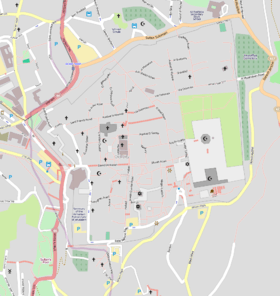 Shown ( | |
| Alternative name | Makam Nabi Daoud; Cenacle |
|---|---|
| Location | Jerusalem |
| Coordinates | 31.77170°N 35.22936°E |
| Type | tomb |
| History | |
| Periods | Late Roman, Byzantine, Crusader, Mamluk, Ottoman, Israel |
| Site notes | |
| Archaeologists | Jacob Pinkerfeld |
| Public access | yes |
It is located on Mount Zion in Jerusalem, near the early 20th century Abbey of the Dormition. The tomb is thought to be situated in a ground floor corner of the remains of the former Hagia Zion, considered a Byzantine church or late Roman-era S synagogue.[3] The building is now administered by the Diaspora Yeshiva, a Jewish seminary group.
Due to Israeli Jews being unable to reach holy sites in Jerusalem’s Old City during the Jordanian annexation of the West Bank (1948-1967), the Tomb of David was promoted as a place of worship, and the roof of the building, above the Cenacle, was sought for its views of the Temple Mount, and thus became a symbol of prayer and yearning.[4][5] The building, built as a church, then transformed into a mosque, was split in two and the ground floor with the Tomb was converted into a synagogue immediately following the end of the 1947–1949 Palestine war; the Muslim cover on the tomb was replaced with an Israeli flag and then a parochet.[6] From then onwards, the Israeli Ministry of Religious Affairs began the process of turning the site into Israel's primary religious site.[7] Jewish prayer was established at the site, and Jewish religious symbols were added.[8] From 1948 until the Six-Day War in 1967, it was considered the holiest Jewish site in Israel.[9]
The tomb compound includes the location traditionally identified as the Cenacle or Upper Room, the original meeting place of the early Christian community of Jerusalem. Recent years have seen rising tensions between Jewish activists and Christian worshippers at the site.[10][11][1]
History
Early history
The tomb is located in a corner of a room situated on the ground floor remains of the former Hagia Zion, an ancient house of worship; the upper floor of the same building has traditionally been viewed by Christians as the "Cenacle" or "Upper Room", the site of the Last Supper. The site of David's burial is unknown, though the Jewish Bible and the Old Testament locate it southwards, in the City of David near Siloam. In the 4th century CE, he and his father Jesse were believed to be buried in Bethlehem. The idea that David was entombed on what was later called Mt Zion dates to the 9th century CE.[2]
The Mount Zion conquered by David according to the Books of Samuel was wrongly ascribed by medieval pilgrims to this site, and David was presumed to be buried there.[2]
Crusader and Franciscan control
Writing around 1173, the Jewish traveller Benjamin of Tudela recounted a colourful story that two Jewish workers employed to dig a tunnel came across David's original splendid palace, replete with gold crown and scepter and decided that the site must be his tomb.[2]
The Gothic cenotaph preserved to this day is the work of the Crusaders.[2]
In 1332 the Franciscans, the officials representatives of the Roman Catholic church in the Holy Places after the final Muslim expulsion of the Crusaders, moved their headquarters to the Cenacle, having acquired it in 1332 from Sultan An-Nasir Muhammad for 30,000 ducats.[12]
Mosque

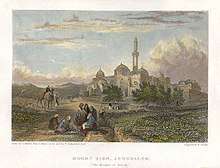
According to Dominican pilgrim Felix Fabri,[13] in 1429 Mamluk Sultan Barsbay took part of the lower floor of the complex away from the Franciscans and converted the tomb chamber into a mosque.[14] Though it was returned a year later, possession alternated back and forth until 1524 when Ottoman Sultan Sulayman (Suleiman the Magnificent) expelled the Franciscans from the entire complex.[15] The resulting Islamic shrine was entrusted to Sufi Sheikh Ahmad Dajani and his posterity.
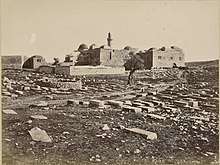
The Franciscan Monastery in Jerusalem during the 16th century did not encompass today's King David Tomb complex. The Sharif Ahmad Dajani, the first to hold the Dajani name, constructed the neglected Eastern side of today's King David Tomb complex—where the tomb is located—in the 1490s. He established a place for Muslim prayer on the Eastern part of today's complex. In 1552 the Franciscans were ejected from the Cenacle, on account of alarm caused by a rumour that some Christian workmen had discovered the Tombs of David and Solomon and the other Kings of Judah.[16] The "Ibn Dawood" mosque, a title given Sheikh Ahmad Dajani by the residents of Jerusalem, was established for Muslim prayers under the patronage of Sultan Suleiman the Magnificent and the supervision of al-Shareef Sheikh Ahmad bin Ali Dajani.[17]
Management of the site was transferred to the Muslim Palestinian family al-Ashraf Dajani al-Daoudi family (descendants of the Prophet Mohammad's grandson Hussein) by an edict from Sultan Suleiman the Magnificent in 1529.[18] Since then, the Dajani family supervised and maintained this site. As a result, they were given the title of Dahoudi or Dawoodi by the residents of Jerusalem in reference to the King David Tomb complex.[19]
During the British Mandate period, the site was not subject to the Status quo of Holy Land sites since it was considered to be "absolutely under the authority of the Moslem Waqf of Nebi Daud, who however arrange to open it to the many that are anxious to visit a site of such sacred traditions".
Israeli control and 1953–54 UN dispute
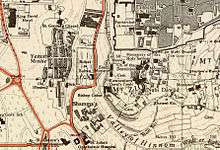
After the 1948 Arab–Israeli War, the southern part of Mount Zion upon which the Tomb stands ended up on the Israel side of the Green Line. Between 1948 and 1967 the eastern part of the Old City was occupied by Jordan, which barred entry to Jews even for the purpose of praying at Jewish holy sites. Jewish pilgrims from around the country and the world went to David's Tomb and climbed to the rooftop to pray.[21] Since 1949, a blue cloth, with basic modernist ornamentation, has been placed over the sarcophagus. The images on the cloth include several crown-shaped Rimmon placed over Torah scrolls, and a violin, and the cloth also features several pieces of text written in Hebrew. The building is now part of the Diaspora yeshiva.
Between 1953 and 1954 a dispute arose over the site at the United Nations.[22] In October 1953, Husayn Al-Khalidi, the Jordanian foreign minister and a previous Mayor of Jerusalem wrote to Moshe Sharett via the United Nations with respect to David's Tomb that: "Israel's flagrant defiance of all United Nations decisions now crowned by a further serious breach of the status quo governing the Holy Places of Jerusalem upheld by Turkish, Mandatory and Jordan regimes. Photographic confirmation now in hand proves beyond doubt Israel's conversion of the Moslem holy mosque Nebi Daoud Cenaculum into a Jewish synagogue.".[22][23] He demanded immediate United Nations intervention; Iraq sent a similar message in December.[22] In February 1954, Israel replied:[24]
Since the establishment of the State of Israel, no architectural, religious or other changes have been made in the Coenaculum room, where the Nabi Daoud is situated, and access thereto is accorded to all visitors in strict accordance with the status quo. No applications by Moslems to visit the place has been refused.[24]
Recent events
In December 2012, unknown persons completely destroyed a large number of 17th-century Islamic tiles in the tomb; the Israel Antiquities Authority has decided not to reconstruct them.[25]
A statue of King David, installed on Mount Zion in 2008 near the Tomb of King David[26] by the Russian Charitable Foundation of St. Nicholas the Wonderworker, was dismantled in 2018. The statue had previously been vandalized several times. The installation of the monument in the old section of the city was negatively received by many representatives of the ultra-Orthodox Jewish community.[27][28]
Question of authenticity
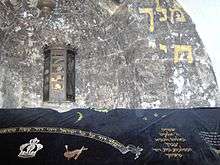
The contents of the sarcophagus have not yet been subjected to any scientific analysis, to determine their age, former appearance, or even whether there is actually still a corpse there.
Historic predecessors: City of David and Bethlehem
The authenticity of the site has been challenged on several grounds. According to the Bible,[29] David was actually buried within the City of David together with his forefathers; by contrast, the 4th century Pilgrim of Bordeaux reports that he discovered David to be buried in Bethlehem, in a vault that also contained the tombs of Ezekiel, Jesse, Solomon, Job, and Asaph, with those names carved into the tomb walls.[30]
"Zion": three consecutive locations
Jebusite fortress
According to the Book of Samuel, Mount Zion was the site of the Jebusite fortress called the "stronghold of Zion" that was conquered by King David, becoming his palace and the City of David.[31] It is mentioned in the Book of Isaiah (60:14), the Book of Psalms, and the first book of the Maccabees (c. 2nd century BC).[31]
Temple Mount
After the conquest of the Jebusite city, located on the ridge west of the Kidron Valley, the ridge's highest part, in the north, became the site of Solomon's Temple. Based on archaeological excavations revealing sections of the First Temple city wall, this is believed to have received the name Mount Zion.[32]
Western hill
Towards the end of the First Temple period, the city expanded westward.[33] Just before the Roman conquest of Jerusalem and the destruction of the Second Temple, Josephus described Mount Zion as a hill across the city's central valley to the west.[31] This indicates that the western hill by then had come to be known as Mount Zion, and this has been the case ever since.[31] It must however be said that Josephus never used the name "Mount Zion" in any of his writings, but described the "Citadel" of king David as being situated on the higher and longer hill, thus pointing at the Western Hill as what the Bible calls Mount Zion.[34][35]
Josephus
The genuine David's Tomb is unlikely to contain any furnishings of value; according to the 1st-century writer Josephus, Herod the Great tried to loot the tomb of David, but discovered that someone else had already done so before him.[36] Elsewhere, in Wars of the Jews, Josephus says that John Hyrcanus took three thousand talents from David's tomb in order to defend Jerusalem against Antiochus VII Sidetes.[37]
Early synagogue: pro and con
The 4th-century accounts of the Bordeaux Pilgrim, Optatus of Milevus, and Epiphanius of Salamis all record that seven synagogues had once stood on Mount Zion.[38] By 333 CE (a date defined by some as the end of the Roman period and beginning of the Byzantine period), only one of them remained, but no association with David's tomb is mentioned.
One fringe theory claims that at the end of the Roman period, a synagogue called Hagiya Zion was built at the entrance of the structure known as David's Tomb, probably based on the belief that David brought the Ark of the Covenant here from Beit Shemesh and Kiryat Ye'arim before the construction of the Temple.[39] However, the scolarly consensus is that "Hagia Sion" (Holy Zion) was the Greek Christian name for the basilica built on the grounds in the late fourth century AD.
Jacob Pinkerfeld, the archaeologist who has worked on part of the site, has also suggested that "David's Tomb" was actually a 2nd-century, Late Roman synagogue.[3]
The identification of David's Tomb as a synagogue has been thoroughly challenged due to the absence of typical synagogal architectural characteristics including (original) columns, benches, or similar accoutrements.[40] The presence of a niche in the original foundation walls, thought by a few to be evidence of a Torah niche, has been refuted by many scholars as being too large and too high (8' x 8') to have served this purpose.[41]
Source of the tradition
David's Tomb
According to Professor Doron Bar,
Although the sources for the tradition of David's Tomb on Mount Zion are not clear, it appears that it only began to take root during the subsequent, early Muslim period. Apparently, the Christians inherited this belief from the Muslims, and only at a relatively late juncture in the city’s history were the Jews finally convinced as well.[42]
Others disagree. The facility was under the control of Greek Christians at this time. It was, indeed, shortly before the Crusades at the earliest that the location of David's Tomb can be traced to Mount Zion.[43] But the first literary reference to the tomb being on Mount Zion can be found in tenth-century Vita Constantini (Life of Constantine).[44] And Ora Limor attributes the localizing of the tomb on Mount Zion to the desire of Roman/Latin Christians to infuse the spirit of the "founding fathers" into the site by imaginatively connecting it with the supposed tombs of David and Solomon.[45]
Having initially revered David's tomb in Bethlehem, Muslims began to venerate it on Mount Zion instead but no earlier than the 10th century following the Christian (and possibly Jewish) lead. In the twelfth century, Jewish pilgrim Benjamin of Tudela recounted a somewhat fanciful tale of workmen accidentally discovering the tomb of David on Mount Zion.[46]
Upper Room and first church
Epiphanius' 4th-century account in his Weights and Measures is one of the first to associate the location with the original meeting place of the Christian faith, writing that there stood "the church of God, which was small, where the disciples, when they had returned after the Savior had ascended from the Mount of Olives, went to the upper room".[47]
Exploration
In the mid-nineteenth century, engineer and amateur archaeologist Ermete Pierotti reported discovering a cavern beneath the grounds of the Byzantine and Crusader churches on Mount Zion which he suspected extended to beneath the Tomb of David.[48] A limited exploration revealed human remains within a huge vault supported by piers. The cavern has yet to be confirmed or scientifically excavated.
In 1951, archaeologist Jacob Pinkerfeld worked in the lower parts of the structure and interpreted them as being the remains of a synagogue which, in his opinion, had later been used as a church by Judeo-Christians.[49]
Alternative burial sites
Archaeologists, doubting the Mount Zion location and favouring the biblical account, have since the early 20th century sought the actual tomb in the City of David area. In 1913, Raymond Weill found eight elaborate tombs at the south of the City of David,[50] which archaeologists have subsequently interpreted as strong candidates for the burial locations of the former kings of the city;[51] Hershel Shanks, for example, argues that the most ornate of these (officially labelled T1) is precisely where one would expect to find the burial site mentioned in the Bible.[51]
See also
| Wikimedia Commons has media related to David's Tomb. |
- Church of Zion, Jerusalem or Church of the Apostles on Mount Zion, Roman-era church or synagogue speculated to have belonged to an early Jewish-Christian congregation
- List of burial places of biblical figures
- Uzziah Tablet, artifact possibly indicating a reburial of King Uzziah's remains
Bibliography
- Vincent, Louis-Hugues (1922). "III: La Sainte Sion et les sanctuaires de second ordre a l'intérieur de la ville". Jérusalem. Recherches de topographie, d'archéologie et d'histoire. 2. Gabalda. pp. 421–668.
- Bar, Doron (2004). "Re-creating Jewish Sanctity in Jerusalem: Mount Zion and David's Tomb, 1948–67". Journal of Israeli History. 23 (2): 260–278. doi:10.1080/1353104042000282401.CS1 maint: ref=harv (link)
- Cust, L. G. A. (1929). The Status Quo in the Holy Places. H.M.S.O. for the High Commissioner of the Government of Palestine.CS1 maint: ref=harv (link)
- Silvio Ferrari; Andrea Benzo (15 April 2016). Between Cultural Diversity and Common Heritage: Legal and Religious Perspectives on the Sacred Places of the Mediterranean. Taylor & Francis. pp. 150–. ISBN 978-1-317-17502-5.
- Breger, Marshall J.; Reiter, Yitzhak; Hammer, Leonard (2009). Holy Places in the Israeli-Palestinian Conflict: Confrontation and Co-existence. Routledge. pp. 105–. ISBN 978-1-135-26811-4.CS1 maint: ref=harv (link)
- Peled, Alisa Rubin (February 2012). Debating Islam in the Jewish State: The Development of Policy Toward Islamic Institutions in Israel. SUNY Press. ISBN 978-0-7914-9006-8.CS1 maint: ref=harv (link)
- Reiter, Yitzhak (7 April 2017). Contested Holy Places in Israel–Palestine: Sharing and Conflict Resolution. Taylor & Francis. pp. 186–. ISBN 978-1-351-99885-7.
- Mizrachi, Yonathan; Veeder, Anna (2014). David's Tomb on Mt. Zion (PDF). Emek Shaveh.
- Wharton, Annabel Jane (2013). "Jerusalem's Zions" (PDF). Material Religion. 9 (2): 218–243. doi:10.2752/175183413X13703410896050.
- Limor, Ora (1988). "The Origins of a Tradition: King David's Tomb on Mount Zion". Traditio. 44: 453–462. doi:10.1017/S0362152900007133.
References
- Isabel Kershner, Mass on Mount Zion Stirs Ancient Rivalries, New York Times, May 26, 2014
- Rabbi Dr. Ari Zivotofsky, 'Where is King David Really Buried?,' The Jewish Press, May 15th 2014.
- Jacob Pinkerfeld, "'David's Tomb': Notes on the History of the Building: Preliminary Report," in Bulletin of the Louis Rabinowitz Fund for the Exploration of Ancient Synagogues 3, ed. Michael Avi-Yonah, Jerusalem: Hebrew University, pp. 41-43.
- Bar 2004, p. 262.
- Jerusalem Divided: The Armistice Regime, 1947–1967, Raphael Israeli, Routledge, 2002, p. 6
- Bar 2004, p. 263.
- Breger, Reiter & Hammer 2009, p. 105: "Director General Kahana was obliged to contend with the problematic nature of the Tomb's status. Immediately after the war he initiated a long series of religious ceremonies that brought about a radical change in the status of King David's Tomb and served to encourage Jewish control of the Tomb structure, in the absence of any official decision by the State of Israel. This endeavor was roundly condemned by various official Israeli bodies from its earliest stages."
- Breger, Reiter & Hammer 2009, p. 106: "Particularly vexing was the matter of the status and definition of King David's Tomb, an issue that was the focus of disagreements and conflicting interests even within the Ministry. On the one hand, it was Kahana himself who initiated extensive Jewish prayer activity at the site, with the goal of eradicating the Muslim past of King David's Tomb. He saw to the placement of numerous Jewish symbols in and around the Tomb, aimed at demonstrating the political-religious change that had taken place at the site and impressing this fact upon visitors. with the concurrence of the Ministry's architectural advisor, Meir Ben Uri, the phrase "David King of Israel Lives and Endures" was painted over the niche above the tombstone, while large oil-burning candelabra were hung nearby."
- Doron Bar, “Holocaust Commemoration in Israel During the 1950s: The Holocaust Cellar on Mount Zion,” Jewish Social Studies: History, Culture, Society n.s. 12, no. 1 (Fall 2005): 16–38 "The development of Mount Zion and David’s Tomb as the holiest site in the State of Israel occurred immediately after the end of the 1948 war, when pilgrims frequented the previously inaccessible tomb... geopolitical change ... followed the Six Day War of 1967. The outcome of the war and the reclamation of the Jewish holy places in the Old City of Jerusalem resulted in the steady decline in the status of David's Tomb and the Holocaust Cellar"
- Eetta Prince-Gibson, Jewish Radicals Disrupt Greek Orthodox Pentecost Prayer in Jerusalem, Calling Worshipers 'Evil', Haaretz, Jun 21, 2016
- Yair Ettinger, Police Evacuate Scores of Jewish Activists Barricading in King David’s Tomb. Hardline Jews barricade inside flash-point religious site, attempting to prevent Christian prayer service., Haaretz, Jun 01, 2015
- Cust 1929, Chapter The Status Quo : its Origin and History till the Present Time section B quote: "in A.D. 1230, the Franciscan Order was established in Jerusalem and became the official representatives of Roman Catholicism in the Holy Places, with their headquarters in the Cenacle on Mount Zion, obtained from the Egyptian Sultan, Melek-el-Nasr, in 1332, for 30,000 ducats".
- Fabri, Félix; Hassler, Konrad Dieterich (1848). Fratris Felicis Fabri Evagatorium in Terrae Sanctae, Arabiae et Egypti peregrinatoniem. 1. sumptibus Societatis litterariae Stuttgardiensis. p. 253.
Judaei multis temporibus et hodie instant apud regem Soldanum pro loco illo, ad faciendum sibi oratorinm: et e contra Christiani reclamabant. Tandem Soldanus interrogavit: qualis tamen sanctitatis esset locus ille?. et cum sibi dictum esset, quod David cum caeteris regibus Jerusalem de ejus semine ibi sepulti essent; dixit: et nos Sarraceni David sanctum tenemus, aeque sicut Christiani et Judaei et Bibliam credimus sicut et ipsi. Locum ergo illum nec illi nec isti habebunt, sed nos enm recipimus, et ita venit in Jerusalem et ostinm illins capellae, per quod ab intra de monasterio erat ingressus, obstruxit, et ipsam capellam profanavit, ejiciens altaria Christi et destruens et delens imagines sculptas et pictas eamque cultu spurcissimo Machometi coaptans, ab extra faciens ostium, ut Sarraceni ingredi possent, dum placeret...
English version, page 303: "The Jews have many times begged the Soldan to give them that place, that they may make an oratory of it, and they beg it of him even to this day : while the Christians have always refused it to them. So at last the Soldan inquired wherefore this place was holy. When he was told that David and the other kings of Jerusalem of his seed were buried there, he said : 'We Saracens also count David holy, even as the Christians and the Jews do, and we believe the Bible as they do. Wherefore neither the Christians nor the Jews shall have that place, but we will take it for ourselves. He thereupon came to Jerusalem and blocked up the door by which one entered that chapel from inside the monastery, desecrated the chapel, turned out Christ's altars, brake the carved images, blotted out the paintings, and fitted it for the worship of the most abominable Mahomet, making a door on the outside by which the Saracens could enter it when they pleased." - Pringle, Denys (2007). The Churches of the Crusader Kingdom of Jerusalem: A Corpus. Vol. 3. The City of Jerusalem. Cambridge University Press. p. 270.CS1 maint: ref=harv (link)
- Pringle 2007, p. 271.
- Limor, Ora (Jan 1, 2007). "Sharing Sacred Space" in edited book In Laudem Hierosolymitani. Ashgate Publishing, Ltd. p. 227. ISBN 9780754661405.
- Feldinger, Lauren Gelfond (8 July 2013). "Israel and Vatican close to signing Holy Land accord". The Art Newspaper.
- "Dajani Daoudi Family Website".
- Jerusalem Divided: The Armistice Regime, 1947–1967, Raphael Israeli, Routledge, 2002, p. 6
- Peled 2012, p. 93.
- Islam: Political Impact, 1908-1972 : British Documentary Sources. 9. Archive Editions. 2004. p. 59. ISBN 978-1-84097-070-8.
- Peled 2012, p. 94.
- Nir Hasson (August 3, 2013). "Who is 'Judaizing' King David's Tomb?". Haaretz.
- The statue of King David, google.com/maps, 2017.
- "Monument to King David gifted by Russian charity dismantled in Jerusalem". Orthochristian.com. March 27, 2018.
- "Haredim want King David statue moved". Ynetnews.com. September 21, 2010.
- 1 Kings 2:10
- Itinerarium Burdigalense 598:4-6
- Bargil Pixner (2010). Rainer Riesner (ed.). Paths of the Messiah. Keith Myrick, Miriam Randall (trans.). Ignatius Press. pp. 320–322. ISBN 978-0-89870-865-3.
- This is Jerusalem, Menashe Harel, Canaan Publishing, Jerusalem, 1977, p.193, 272
- This is Jerusalem, Menashe Harel, Canaan Publishing, Jerusalem, 1977, p.272
- Flavius Josephus (October 2001). The Wars of the Jews or History of the Destruction of Jerusalem. Translated by William Whiston. Project Gutenberg. Retrieved 19 February 2016.
The city was built upon two hills, which are opposite to one another, and have a valley to divide them asunder; [...] Of these hills, that which contains the upper city is much higher, and in length more direct. Accordingly, it was called the "Citadel," by king David; [...] Now the Valley of the Cheesemongers, as it was called, and was that which we told you before distinguished the hill of the upper city from that of the lower,... (Book 5, Chapter 4, §1; or V:137)
- The genuine works of Flavius Josephus..., translated by William Whiston, Havercamp edition, New York (1810). See footnote on page 83. (copy&pg=PA83 David's Tomb, p. 83, at Google Books)
- Josephus, Antiquities of the Jews, 16:7:1
- Josephus, Wars of the Jews 2:5
- Bordeaux Pilgrim, Itinerarium Burdigalense 20; Optatus of Milevus, Contra Donatistas 3.2; Epiphanius of Salamis, De Mensuris et Ponderibus 14 (54c).
- This is Jerusalem, Menashe Harel, Canaan Publishing, Jerusalem, 1977, p.273
- Clausen, David (2016). The Upper Room and Tomb of David: The History, Art and Archaeology of the Cenacle on Mount Zion. Jefferson, NC: McFarland. pp. 168–175. ISBN 9781476663050.
- Jerome Murphy-O'Connor, The Holy Land: An Oxford Archaeological Guide From Earliest Times to 1700, 5th ed. (New York: Oxford University Press, 2008), 117; Oskar Skarsaune, In the Shadow of the Temple: Jewish Influences on Early Christianity (Downers Grove, IL: InterVarsity Press, 2002), 189; Joan Taylor, Christians and the Holy Places: The Myth of Jewish-Christian Origins (Oxford: Clarendon Press, 1993), 215; Clausen, 158-163.
- Bar 2004, pp. 260–278.
- Pixner, Paths 352; Clausen, Upper Room 57.
- Anonymous, Vita Constantini 11.
- Ora Limor, "The Origins of a Tradition: King David's Tomb on Mount Zion," Traditio 44 (1988): 459.
- Benjamin of Tudela, Masa'ot Binyamin 85.
- Epiphanius of Salamis, Weights and Measures (1935) pp.11-83. English translation
- Ermete Pierotti, Jerusalem Explored: Being a Description of the Ancient and Modern City, 2 vols., trans. Thomas George Bonney (Cambridge: C. J. Clay, 1864), 215.
- Elizabeth McNamer, Bargil Pixner Jesus and First-Century Christianity in Jerusalem p6 8, 2008 "In 1951, archaeologist Joseph [sic] Pinkerfield found on Mount Zion the remains of a synagogue ... Pinkerfield also found pieces of plaster with graffiti scratched on them that came from the synagogue wall. "
- Kathleen Kenyon, Archaeology in the Holy Land (1985), p. 333.
- Hershel Shanks, Biblical Archaeology Review, January/February 1995, p. 64.